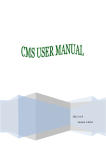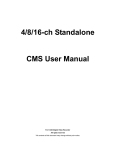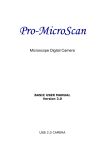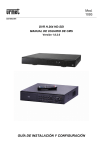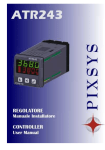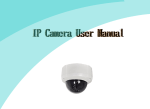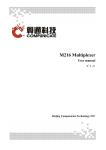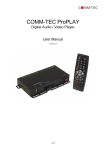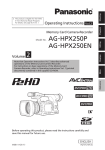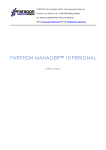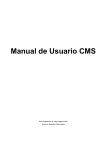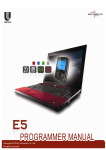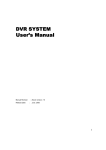Download CMS USER`S MANUAL
Transcript
CMS USER’S MANUAL 2010-5-21 1 INDEX INDEX ............................................................................................................................... 2 Preface.............................................................................................................................. 3 1. Introduction ................................................................................................................ 4 2. Install and uninstall CMS............................................................................................ 4 2.1 System requirement ........................................................................................ 4 2.2 Computer Hardware Requirements................................................................. 4 2.3 Process of Installation ..................................................................................... 5 2.4 Remove the Software...................................................................................... 7 3. Login and exit............................................................................................................. 7 3.1 Login ............................................................................................................... 7 3.2 Exit .................................................................................................................. 9 4. Functions and operations........................................................................................... 9 4.1 Basic function.................................................................................................. 9 4.1.1 Lock & Unlock..................................................................................... 10 4.1.2 Minimize & Maximize.......................................................................... 10 4.1.3 Alarm Display ..................................................................................... 10 4.1.4 Camera Display List ........................................................................... 10 4.2 Preview ..........................................................................................................11 4.2.1 Preview Locale ....................................................................................11 4.2.2 PTZ configuration ............................................................................... 14 4.2.3 Video Set ............................................................................................ 16 4.3 Remote System Configuration ...................................................................... 16 4.3.1 Device manager ................................................................................. 16 4.3.2 Local configuration ............................................................................. 22 4.3.3 Server Configuration........................................................................... 27 4.3.4 E-map................................................................................................. 27 4.3.5 User Manager..................................................................................... 30 4.3.6 Decode card ....................................................................................... 34 4.4 Video Search................................................................................................. 35 4.4.1 Video playback ................................................................................... 36 4.4.2 Video backup...................................................................................... 39 5. Use method for IP-TOOL ......................................................................................... 40 6. Troubleshooting ....................................................................................................... 44 2 Preface Central management software (short for CMS below) is a typical client management program whose main function is to centralize all devices together and realize the unified management of parameters and authorization, which is greatly improve the efficiency of control and operation to all embedded digital video recorders and network video servers as well as software compressed cards connected through the network. This manual will help you to familiarize with the software and master its operation methods. Notice: z As product update, the contents of this manual are subject to change without notice. z Some part functions and symbols may not be completely same with what you get due to the continuous revision of this software. 3 1. Introduction Central Management Software is a client procedure designed especially for embedded digital video recorders, network video servers and software compressed cards to realize remote centralized management. In the video surveillance system, the administrator can control video input devices and conduct all possible rights such as setting up cameras, PTZ, etc through configuring parameters, viewing the live site to achieve the purpose of live site surveillance, video record and record file backup and so on. It possesses three main functions: preview the live site, system configuration and video search, which will be presented specifically in the third function part. 2. Install and uninstall CMS 2.1 System requirement z Supported Operating System: Operating system Windows XP Windows 2000 Windows Vista Comments Windows XP SP2 or most updated patch, Direct 9.0c or the higher Windows 2000 SP4, Direct 9.0c or the higher Windows Vista Direct 10.0c or the higher Note: Windows 2003 series. z Supported Browser Operating system Microsoft Internet Explorer v6.0 Microsoft Internet Explorer v7.0, 2.2 Comments IE 6.0 with most updated service pack IE 7.0 with most updated service pack Computer Hardware Requirements To ensure the software running well, please make sure the computer is compatible. z Recommended PC Specification – 4 channels Item CPU Memory Specification Intel Pentium 3.0 GHz or AMD 3000+ 1GB 4 HDD 160GB z Recommended PC Specification -8 channels: Item CPU Memory HDD Specification Intel Core 2 Duo 1.8 GHz or AMD Dual core 3800+ 1GB 250GB z Recommended PC Specification -16 channels: Item CPU Memory HDD Specification Intel Core 2 Duo 2.2 GHz or AMD Dual core 3800+ 2GB 250GB Note: z The upper recommended specification aims at CIF real-time resolution. z The AMD chip hyper-3800+ and X64 series are not tested; z If user wants to have real-time live view with CIF resolution, the max connection number is 16 in one computer according to the current capacity; z If user wants to have real-time live view with D1 resolution, the max connection number is 4 in one computer. 2.3 Process of Installation a) Before to install central management software in your computer, please make sure all the anti-virus software in your computer closed so that the control center program can install correctly in your computer. In addition, the setting of your IE browser must enable the download of activeX control. b) Run the “Control Center” from software CD, the next menu will pop up; Figure2-1 Welcome menu 5 Click “Next” to enter the next step; Figure2-2 Choose the installation destination The default installation destination folder is “C:\Program Files”, user could click “Browser” button to change it. After selecting the destination, click “Next” to enter the next step. Figure2-3 Type a new folder name or select an existing folder to install Click “Next” to start installing; Figure2-4 The rate of installation progress The installation is completed. 6 Figure2-5 Completed menu 2.4 Remove the Software There are two methods to remove the software. One method to uninstall the software is like all other software. Users shall enter the removal interface and then click 'remove" to uninstall this control center. The other way is to click the setup icon, and then a window shown below will pop up, users select "Remove" to dismantle this software. After Removed, the computer system will reboot automatically. 3. Login and exit 3.1 Login After building Network Video Surveillance System and installing the Control Center program, user need login the Control Center to set parameters and watch the locale. Steps of login are described as below: 7 Double-click icon on the desktop, it will pop up 'create SYSTEM password ' dialog box, referred to Figure3-1. Figure 3-1 create SYSTEM password User can self-defined the user’s password, letters or numbers, 32 characters at most. The default original username is SYSTEM. Input the correct Email address in the server address text box, If user forget the password, the system will auto send it to user’s defined email address; After finished above setting, click “test your account settings” button to test the email address, if the networks is connected, there will pop up a “success” dialog, and vice versa. Click OK button to enter the Login interface, refer to Fig3-2, and input the password in the password text box. If user forget the password, can press “get system password” button to get it according to the direction. Fig 3-2 login interface Click 'OK' button to enter the Control Center. The Control Center Operation Interface is shown as Figure3-3. 8 Figure 3-3 Control Center Operation Interface 3.2 Exit There are two ways to exit control center normally. Firstly, please click button, and then an inquiry dialogue will pop up. If you confirm to exit, please click "yes", the system will close. Secondly, user can click button to exit. 4. Functions and operations In this chapter we will divide four parts to instruct the functions and specific operations of this software. Users can enter the control center to watch locale through Internet, to set parameters, to enable the record, to playback the record files, and to backup the record and so on. Main Function List: z Basic Function z Preview z Remote System Config z Video Search 4.1 Basic function After entering the Control Center, users can operate following functions. The operation methods are described as below: 9 4.1.1 Lock & Unlock 'Lock & Unlock' button. expresses the Operation Interface is on 'Unlock' status. expresses the Operation Interface is on 'Lock' status. User could lock current operation interface. When current operation interface is on 'Lock' status and user need to operate the Control Center, he needs input username and password on 'Login' dialog box to unlock the Control Center Operation Interface. The Control Center Operation Interface which user could operate is on 'Unlock' status. 4.1.2 Click Minimize & Maximize to maximize 'Control Center' window. Click to minimize 'Control Center' window or revert the 'Control Center' to original size. 4.1.3 Alarm Display In the alarm display item, all the alarm information will be displayed. It mainly includes: Alarm Type, Device Name, Camera Number and Alarm Time as well as video lose, motion and so on. Alarm Display List is shown as Figure4-1. Figure4-1 Alarm Display List 4.1.4 Camera Display List Camera Display List is used to display all devices added. User may Click 'Device List' or 'Camera Group' page to switch display mode. Figure4-2 displayed the DVS aligned according device list. User may drag device in the Device List to Operation area for watching the locale. Figure3 displayed the DVS aligned according camera list. User may drag the group to Operation area for watching all camera of this group. 10 Figure4-2 Device list Figure4-3 Camera group If user needs add region, group or device, please refer 'Device Manager ' to add. Notice: Before switching the display mode, user needs click button firstly and then close all preview pictures. 4.2 Preview On Menu area, after clicking 'Preview' menu, it will display the locale preview picture on Operation area. Main function of 'Preview' menu contents: Preview Locale, PTZ Configuration and Video Set. Function List: z Preview Locale z PTZ Configuration z Video Set 4.2.1 Preview Locale In the operation area, users can select preview mode of locale, select automatic dwell, snap picture and close all previews, etc. Function Buttons of Preview Locale are described as table4-1. 11 Table1 Function Buttons & Explanation of Preview Locale No. Buttons Meanings 1 Single Picture Preview' button. Click this button to watch every camera in single picture preview mode. 2 '4 Picture Preview' button. Click this button to watch every camera in four picture preview mode. 3 '9 Picture Preview' button. Click this button to watch every camera in 9-picture preview mode. 4 5 6 7 8 8 9 '16 Picture Preview' button. Click this button to watch every camera in 16-picture preview mode. 25 Picture Preview' button. Click this button to watch every camera in 25-picture preview mode. '36 Picture Preview' button. Click this button to watch every camera in 36-picture preview mode. Click this button to select 6-picture 6-picture preview Click this button to select 8-picture 8-picture preview Click this button to select 13-picture 13-picture preview Click this button to select 49-picture 49-picture preview Click this button to select 64-picture 64-picture preview Turn on sound button, click this button to turn on audio signal 'Snap' button. Click this button to snap locale picture of one camera you select. User could snap 10 pictures once at best. Click 'Snap' button to pop up a dialog, referred Figure2. 'Close All Preview' button. Click this button to close current locale picture and stop preview. Before switching display mode, user must close all previews first. 'Dwell' button. Range of selecting to dwell is from single picture preview mode to 9 picture preview mode. Notice: 12 z Dwell means to display every locale picture according to the sequence of the DVS in Camera Group. z Only when selecting 'Camera Group' on Camera Display List area and current display mode couldn't display all cameras, 'Dwell' button is enabled. z It will dwell among the cameras that have locale pictures. 'Dwell Group' button. Notice: 10 z Dwell means to preview the group picture according to setup camera group z This button is available only the group dwell function is set up z It will dwell among the groups that have locale pictures. 'Pre-Group' button. Click this button to display pre-group locale pictures. Notice: 10 If there are some cameras not connecting with locale pictures, please click 'Pre Group' button, they will be also displayed on the screen, but it only displays in blue screen. 'Next Group' button. Click this button to display next group locale pictures. Notice: If there are some cameras not connecting with locale 11 pictures, please click 'Next Group' button, and they will also be displayed on the screen, but it only displays in blue screen. Users can right-click on the live preview picture to do below operation: • Turn off the live: turn off live picture of current channel • Start Manual Record: start current channel to record. After close live preview, the manual record of this channel will stop. • Stop Manual Record: stop current channel to record. • Enable audio: Enable audio of live picture of current channel • Full screen: Full screen display all live picture in the operation area. At the full screen mode, double-click mouse or right-click can exit the full screen mode; user can output the live preview pictures to another monitor by select \\.\DISPLAY1 or \\.\DISPLAY2. When output the live preview picture to \\.\DISPLAY1, user can do other operation on \\.\DISPLAY2. 13 Figure 4-4 Camera preview Figure4-5 “Snap” Dialog Box 4.2.2 PTZ configuration After connected with dome, user can control the dome on Control Center. User could control the dome up, down, right, left or stop rotating, adjust 14 rotation speed, Iris and zoom, focus on the dome, and set the presets and so on... Function List: z Dome Control z Preset Setting 4.2.2.1. Dome control On 'PTZ Configuration' menu, user could control rotation position and speed of the dome. Function buttons of the Dome Control are described as Table4-2 Table1 Function Buttons & Explanation of PTZ Configuration No. Buttons Meanings means the dome rotate up. means the dome rotate down. means the dome rotate 1 left. means the dome rotate right. means the dome stop rotating. Drag the bar to adjust rotating speed of the 2 dome. 'Iris' button. Click button near 'Iris' button to 3 increase light of the dome. Click button near 'Iris' button to decrease light of the dome. 'Zoom' button. Click button near 'Zoom' button to zoom in the locale picture of this 4 camera. Click button near 'Zoom' button to zoom out the locale picture of this camera. 'Focus' button. Click button near 'Focus' 5 button to have long focus. Click button near 'Focus' button 4.2.2.2. Preset setting Preset means user sets a camera surveillance point for a special position of the locale. When setting the preset, user may adopt function buttons in Table1 of Dome Control to adjust the dome, so that it will display the best picture of locale on Control Center. z Setting Steps i. Click button in item, it will pop up a drag-down list. ii. Select the preset which user wants to set in drag-down list. iii. Use function buttons in Table1 of Dome Control to adjust the dome. iv. Click button, it will pop up 'Modify Name' dialog box. v. Input the preset name in 'preset' textbox. vi. Click 'OK' button to save the preset which you set. z Parameters Configuration Parameters and explanation of setting preset refer below table. Parameters Meaning How to Set... preset Name of the Input manually. It could input 11 15 preset. 4.2.3 characters at most. Video Set On Video Set menu, user could set the quality of locale picture. Function buttons of the Video Set are described as belowTable4-3. Table 1 Function Buttons & Explanations of Video Set No. Buttons Meanings 1 Brightness adjustment 2 Contrast adjustment 3 Saturation adjustment 4 Hue adjustment 5 Sound adjustment Notice: Click 'Default' button to resume the default settings. 4.3 Remote System Configuration On Menu area, after clicking 'System Configuration' menu, there will display the entire submenu. Main function of the System Configuration contents: Device Manager, Local Configuration, Server Configuration, E-map, User Manager, Log Inquiry and Decoder Card. Function List z Device Manager z Local Configuration z Server Configuration z E-map z User Manager z Log Inquiry z Decoder Card 4.3.1 Device manager User could add regions, groups and devices to manage all DVS in the network. After adding regions, groups and devices, they will display on Camera Display List area Function List z Add Region z Add Group z Dwell Setup z Add Device z Modify z Delete 4.3.1.1 Add region User may set regions. The regions could be an indoor environment, outdoor 16 environment or other area. Setting Steps: i. On System Configuration menu, click 'Device Manager’ display 'Device Manager' interface. , it will button, it will pop up 'Add Region' dialog box. ii. Click Input the region name in 'Region' textbox. iii. Click 'OK' button, it will display the added region on Device List box and Camera Display List area. Notice Before adding sub region, user needs select parent region first. If user doesn't select any region, it means adding senior region. Parameters Configuration Parameters and explanation of adding region refer to below table. Parameters Meanings How to Set... Region Region name of the DVS. Input manually. It can input 32 characters at most. Parent Region Superior region. Display parameter. region of current 4.3.1.2 Add group User may set camera group. The group could be some floors, rooms or other groups which installed in the DVS. Setting Steps i. ii. iii. button, it will pop up On 'Device Manager' interface, click 'Add Group' dialog box. Input group name in 'Group Name' textbox which the DVS belong to. Click 'OK' button, it will display the added group on Device List box and Camera Display List area. Notice When adding parent group, user must unselect any group and click button to add. Parameters Configuration Parameters and explanation of adding group refer below table. Parameters Meanings How to Set... Group Name Group name of the DVS. Input manually. It will input 32 characters at most. 4.3.1.3 Dwell Setup User can setup the preview dwell function between groups. Setting Steps 17 1. On 'Device Manager' interface, click button, it will pop up 'Dwell setup' dialog box. Refer to below picture: 2. After add group, user can view the group information in the dwell setup list box on the left side; check the box before camera group , then this group is added to dwell group list box on the right side . 3. After setup the dwell group, user can setup the dwell time which range from: 5 seconds,10 seconds,20 seconds,30 seconds, 60 seconds, 2 minutes. 4. User can return to “Live” interface, click “Dwell” icon to do dwell. Refer to below picture: 18 Parameters Configuration Parameters and explanation of adding group refer below table. Parameters Meanings How to Set... Group name of the Input manually. It will input 32 characters Group Name DVS. at most. Double-click the “dwell time” user can Dwell interval time select the dwell interval time range Dwell Time between groups from:5 seconds, 20 seconds , 30 seconds,60 seconds, 2 minutes. 4.3.1.4 Add device Only after adding region or group, user could add the DVS below region and group. User may select region or group every time to add the DVS. We take adding device in the region as example to describe steps. Setting Steps i. On 'Device Manager' interface, select the region in Device List and ii. iii. click button; it will pop up 'Add Device' dialog box. Click 'Search Device' button, it will pop up 'DVS searching' dialog box. Double-click the DVS in left device list to go back 'Add Device' 19 dialog box. iv. Input the DVS name in 'Device Name' textbox. v. Select data type in 'Bit rate Type' drag-down list. Notice User may set data type in 'System Configuration -> Server Configuration-> Camera Configuration' after adding the DVS, referred Channel Configuration'. We suggest user selecting first stream in LAN and selecting "small stream" in WAN. vi. Select IP of the DVS in 'IP Address' drag-down list. vii. Input username and password of the DVS in 'User Name' and 'Password' textbox. The default username and password of the DVS are admin and admin. viii. Input the visiting port of the DVS in 'Port' textbox. Notice • If the DVS is in LAN, user may use the default port: 9008. If the DVS is in WAN, user need set only one port for every DVS so that the computer in network could visit the DVS. • If the DVS is in WAN, user could modify port in 'Server Configuration->Net Configuration', referred ' Net Configuration '. ix. Click 'OK' button to display the added DVS in the Device List. Parameters Please refer to the following table for parameters and instructions of adding device. i. For the device added successfully, all channels it connecting with will display under the name of the device. Herein, we only introduce the network video surveillance server with single channel, thus the server can only connect with the one video input terminal. ii. This icon denotes region or group; server; iii. it denotes device, viz. it denotes channel After added device to "device edition" box, users can add the channel in the device to the relative channel group, and then select the channel group in" channel group edition" box and click button,and the channel will be added in the channel group. If the channel is in the recycling condition, please close live preview at first and then add the channel to the group. Parameters Meanings How to set The name of the Input manually, 32 characters at Device name device most Net transmission type Select at the pull-down list, Streaming of video & audio data selectable items: main stream and type of server sub-stream. 20 IP address of the After searched device, select at the server pull-down list. Name of the region Region name System display item where the device is User name to visit Input manually, 19 characters at User name server most. Password to visit Password input manually, 19 characters at most server Server Port number to visit Input manually, 32 characters at terminal server most. 4.3.1.5 Modify Users can modify region names, group names, device names and channel names. Setting Steps i. Modify Region IP address z z z z z z z z z In camera group list, select the group and click 'Modify Group Info' dialog box. Input new group name in 'Group Name' textbox. Click 'OK' button to modify the group name. ii. Modify Group button, it will pop up In camera group list, select the group and click 'Modify Group Info' dialog box. Input new group name in 'Group Name' textbox. Click 'OK' button to modify the group name. iii. Modify Device button, it will pop up In device list, select the device and click 'Modify Device Info' dialog box. Input new device name in 'Device Name' textbox. Click 'OK' button to modify the device name. iv. Modify Channel button, it will pop up z In device list, select group name and click button, it will pop up 'Modify Channel Info' dialog box. z Input new channel name in 'Channel Name' textbox. z Click 'OK' button to modify channel name. Parameters Configuration Parameters and explanations to modify region names, group names, device names and channel names refer to table below. Parameters Meanings Modify region name Setup 21 Region name Superior region Group name Device name Name of the region where monitor points are Parent region name Modify group name Name of the group where monitor points are Modify name Name of the device Channel name Net transmission type of video & audio data IP address of the server Name of the region where the device is User name of the server to visit password of the server to visit Terminal number of the server to visit Modify channel name Channel number in the device Channel name Channel name in the device Stream type IP address Region name User name Password Terminal server Input manually, 32characters at most System display item Input manually, characters at most 32 Input manually, characters at most 32 System display item System display item System display item System display item System display item System display item System display item Input manually, 32characters at most 4.3.1.6 delete Users can delete region, group, device and channel. Setting Steps i. Select the region, the group, the device or the channel needing to be deleted. ii. iii. 4.3.2 Click button, pop up "confirm" dialogue box Click “yes” button to delete this item Local configuration In the system configuration interface, after clicking “local configuration" submenu, in the operation area all setting tags will pop up. The setting functions of local configuration are: local basic configuration, local schedule configuration and local alarm configuration. Function List z Local basic configuration z Local schedule configuration z Local alarm configuration 4.3.2.1. Local basic configuration 22 In the “local basic configuration" interface, users can set live configuration, record configuration, local alarm configuration, log list maintain, other configuration, PC restart configuration and version information. Setting Steps i In the “system configuration" menu, click "local configuration” icon. ii The “local configuration" will pop up in the operation area. iii Select “local basic configuration" tag, and the “local basic configuration" interface will appear. iv In " preview setting" box, set display time and headline display mode of the channel at recycle play v In the "video setting" box, set whether to do record recycle and set save path of video files. vi In the "server alarm configuration" box, set alarm holding time for each alarm and post-alarm record time. vii In the "maintenance of journal" box, set periods to save alarm journal and operation journal. viii In the “other configuration “box, set picture numbers being cut for each time, save path to store copy files and control center time. Note: Users can set control center time by themselves, or select the time synchronous with the computer ix In the “PC restart configuration “box, input user name and password of the 23 PC, the interval by day and date and tick off the “PC Auto Restart”, the device will auto restart according to setups. x After finished, select any other operation interface to save the setting. Parameters Please refer to the following table for parameters and instructions of local basic configuration. Parameters Meanings Settings Live configuration Select at the drag-down list, set the holding time in one selectable items 5s、10s、 dwell time picture at recycle play 15s、20s、30s、40s、50s and 1min. Set live picture numbers Select at the drag-down list, Snap picture being cut each time for users can set up to photo numbers single channel 1--30 pictures select at the drag-down list, Channel and device selectable items: none, Title information displayed on channel name and device the top of live pictures name +channel name Record configuration To set whether to continue recording to cover the Recycle Tick off the check box in the earliest video file when the recording front of " recycle record" disc storing video files is full. set save path of video files, Tick off the check box in the Record partition users can set many a discs front of the disc. to save video files Local alarm configuration Select at the drag-down list, Alarm holding .Alarm holding time after selectable items 10s、20s、 time being triggered 30s、40s、1min. and 2min. Select at the drag-down list, Post-alarm Recording time after alarm selectable items:10s、20s、 Record time being triggered 30s、1min.、2min.、5min and 10min. Log list maintenance Select at the drag-down list, Alarm log list set periods to save alarm selectable items : within one save journal week, within half a month and within one month Save time of Set periods to save Select at the drag-down list, operation journal operation journal selectable items: within one 24 week, within half a month Other configuration Set live picture numbers Serial port being cut each time for Select at the drag-down list single channel Set the value according to Select the value at the Baud Rate the setting of speed dome drag-down list Users can input manually( must 14 numbers) Time Set control center time and also may select the time synchronous with computer ( click " rectify" to realize) PC Restart Configuration User Name User name of PC User can input manually Password Password of PC User can input manually Per day The restart interval by day User can input manually Restart time The restart interval by time User can input manually Version information Display software version software version number in the control System display item center 4.3.2.2. Local schedule configuration Schedule record refers to the system to record according to the fixed record time of single channel. In “local schedule configuration" interface, users can set record periods of every week and record periods in special days, viz. week schedule and day schedule. Setting Steps 4.3.2.2.1 Week Schedule Configuration User could set the record time from Monday to Sunday for recording everyday in one week. i On 'Local Configuration' interface, select 'Local Schedule Configuration' page, it will display 'Local Schedule Configuration' interface. ii In device list of left Operation area, select camera to set week schedule, and click iii button. On 'Week Schedule' item, drag the mouse to the weekday, and drag to select the time when there is in blank area. Notice Ruler means 24 hour in one day, the lest graduation is 15 minutes. After setting, user could select other interface to save the settings. 4.3.2.2.2 Day Schedule Configuration 25 User could set record time for recording in some time of special day, such as holiday. i On 'Local Schedule Configuration' interface, select camera to set day schedule in device list of left Operation area. ii On 'Day Schedule' item, input date which needs to set schedule in 'date' textbox, or click near 'date' textbox to select. iii Click button, move the mouse to 'Holiday' item in 'Date Schedule' item, drag to select time when there is in blank area. iv After setting, user could select other interface to save the settings. 4.3.2.2.3 Local alarm configuration Local alarm configuration is a kind of alarm mode of control center which is triggered by alarm after alarm input device (such as motion detection sensor, infrared sensor etc.) detects alarm information. Setting Steps i In the “local configuration" interface, select” local alarm configuration" tag, and the" local alarm configuration" interface will pop up. ii In the “local alarm configuration" interface, select a channel in one server in the left device list. iii In the “alarm type” list, click to select one alarm type of the channel, e.g. “motion detection". Note: When to select a server in the left device list, users can do alarm linkage configuration to select the sensor connecting with device in “alarm type ". iv In the “alarm linkage type" list, tick off alarm linkage type needing to trigger. Note: z alarm linkage mode: sound alarm, e-map alarm and linkage channel record Sound alarm is control center sound "di, di" in which is triggered by alarm information when the sensor detects alarm. Sound alarm can be triggered by sensor alarm, motion detection or video loss. E-map alarm is that alarm information triggers the alarm input device which is opposite to the scene in the e-map to alarm by blinking. After setting alarm link of alarm information and e-map alarm, users should set the relative camera of alarm link in the e-map and map configuration. For further details, please refer to chapter “set camera” Linkage channel record is that alarm information triggers the channel to record when the sensor detects alarm. After setting up linkage channel record, if users need to modify alarm time and record time, please refer to "local basic configuration" to modify. Linkage record alarm may be triggered by sensor alarm or motion detection alarm. z After set the mode of alarm, users need to set alarm input and relative alarm output data in the “server alarm configuration" interface of the 26 menu” local configuration". After finished, select any other interface to save the setting. v 4.3.3 Server Configuration Please refer to the user’s manual of DVR or DVS, which is packed in the box with the device. 4.3.4 E-map In the menu region, click "e-map", and the setting function will appear in the operation region. The setting functions of e-map are map configuration and map alarm. E-map is a plan which is to simulate pictures in the scene. In the e-map, users can add or delete camera at the position which is opposite to the scene as well as set e-map alarm. Function List z Map configuration z Map alarm 4.3.4.1 Map configuration In the interface of “map configuration", users can add or delete e-maps, modify map names, and set whether to start map alarm function. Functions List z Add maps z Add brother nodes z Add sub nodes z Modify map names z Delete sub nodes z Set camera z Change icon z Delete camera 4.3.4.1.1 Add maps Users can add many e-maps in the map adding area. Setting Steps i. In the " system configuration" menu, click " e-map" icon “E-map" interface will pop up in the operation region. ii. In the "e-map" interface ,click "map configuration" button,and iv. then right-click in the "map" tree, quick menu will pop up. In the quick menu, select "add map", and the dialogue box to add map will pop up. Input name of the map at the text box " name" v. In the “path" box, click iii. button, and the “open" dialogue box will pop 27 up. Select the save path of e-map, and click "open" button to confirm path. Click “confirm" button to add e-map in control center successfully. 4.3.4.1.2 Add brother nodes Users can add e-maps which is parallel with the previous map. Setting Steps vi. vii. i. In the " e-map" interface, click “map configuration” button,and iii. then right-click the added map in "map" tree, the quick menu will pop up. In the quick menu, please select "add brother nodes", a dialogue of "add map" will pop up. Input name of the map at the text box of “name". iv. In the "path" box ,click ii. v. vi. button, and the " open" dialogue will pop up. i. Select the path to save e-map, and click "open" button to confirm the path. Click "confirm" button to add map in the map control center successfully. 4.3.4.1.3 Add sub nodes Users can add sub nodes in the previous maps. Setting Steps In the “e-map” interface,click “map configuration” button,and click the added map in the" map" tree with the right key of the mouse, and a quick menu will pop up. ii. In the quick menu, select “add sub node",” add map “dialogue will pop up. iii. Input the name of the map at the text box of "name" button, " open" dialogue will pop up. iv. In the “path” box,click v. Select the path to save e-map and click “open" button to confirm the saving path. vi. Click "confirm" button to add map in the map control center successfully. 4.3.4.1.4 Modify map names Users can modify e-map names. Setting Steps i. In the “e-map” interface,click “map configuration” button,and then right-click the added map in the " map" tree, and a quick menu will pop up. ii. In the quick menu, select "modify sub node names", the dialogue of "modify map name" will pop up. iii. Input the name of the map at the text box of "name" iv. Click "confirm" button to modify the e-map name successfully. 4.3.4.1.5 Delete sub nodes Users can delete e-maps. 28 Setting Steps i. In the “e-map” interface,click “map configuration” button. ii. In the “map" tree, select the map needing to delete and then right-click, a quick menu will pop up. iii. In the quick menu, select “delete node", the "confirm" dialogue will pop up. iv. Click "yes" button to delete the map. 4.3.4.1.6 Set camera Users can set a camera in the e-map where is opposite to the live. Setting Steps i. In the “e-map” interface,click “map configuration” button. ii. In the “map” tree,select the map to add camera. iii. Select a channel in the server at the left device list of control center, drag the channel into the e-map where is opposite to the live. Note: z In this way, the channel in the server will connect with camera. z After set the camera, users can click button to select the relative map, and then select the camera in the map to click right key to watch live pictures. 4.3.4.1.7 Change icon Users can change camera icon according to the type of camera connected with in the live, Setting Steps In the "e-map" interface, click "map configuration" button. i. Select the camera needing to change icon in the e-map and click right key of the mouse, and a quick menu will pop up. ii. In the quick menu, select "change icon", and the dialogue "change icon" will pop up. iii. Select the type of camera at the "icon" box iv. Click “confirm" button to change the icon of the camera successfully. 4.3.4.1.8 Delete camera Users also can delete the camera according to their specific requirement. Setting Steps i. In the “e-map” interface,click “map configuration ” button. ii. Select the camera needing to change icon in the e-map and then right-click mouse, a quick menu will pop up. iii. In the quick menu, select "delete”, and “confirm" dialogue will pop up. iv. Click "yes" button to delete the camera successfully. 4.3.4.2 Map alarm Map alarm refers to the camera in the map will blink to alarm after receiving the 29 alarm information which is detected at the live. It is necessary for the user to set the link of camera and alarm type in “local alarm configuration" of” local configuration in the system configuration and set the schedule of camera alarm type in “server alarm configuration in “remote configuration". Setting Steps i. ii. iii. iv. In the “e-map" interface, click “map alarm” button. Select e-map in the “map" tree. Select the camera which is blinking to alarm and then right-click the mouse and the window of live pictures will pop up. Click “Exit" button to exit the window of the live pictures. Users can right-click on the map alarm display area to do below operations: Return to present map: return to parent map from a sub-map Full screen: user can output the live preview pictures to another monitor by select \\.\DISPLAY1 or \\.\DISPLAY2. When output the live preview picture to \\.\DISPLAY1, user can do other operation on \\.\DISPLAY2 Exit Full screen: click “Exit Full screen” can exit the full screen live pictures. 4.3.5 User Manager For the administrator, they have the right to add common users and set server menus that they have right to visit. Notice: The administrator can add users to visit one server at user configuration of remote configuration in system configuration; and also the administrator can add users to operate one control center and visit some channel in a server at “user administration" of system configuration. Function List z Add user z Set authorization z Modify password z Delete users 4.3.5.1 Add user For the users added successfully, they can operate control center in the range of authorization which is endowed by the administrator. But, for the common user, they can only modify their password in the menu of "user administration" in” system configuration". Setting Steps i. In “system configuration” menu,click “user administration” button, and the " user administration" interface will appear in the operation region. ii. Click “add user” button, and the dialogue of "add user" will pop up. 30 iii. Input user name and password for common user in the text boxes of "user", "password" and "confirm", respectively. iv. Click "confirm" button to add user successfully. Parameters Parameters meanings Settings User names that user logs in Input manually, 32 user name control center. characters at most Password for user to log in Input manually, 32 Password control center characters at most The right class of the user which User class System display item can be classified The password for users to log in control center. Confirmed Input manually, 32 password characters at most Note: Confirmed password must accord with the password 4.3.5.2 Set authorization After added user, the administrator can set common user's authorization. Setting Steps i. In the “user administration" interface, select the user needing to modify operation authorization at the user list. ii. In the authorization list, select the menu authorization to impart it to the user. iii. After finished, select any other operation interface to save the setting. 4.3.5.3 Modify password Administrator can modify their password, and also can reset common user's password to resume it as default password. The following will introduce the steps to modify their own password. Setting Steps i. In the “user administration” interface,click “modify” dialogue box of " modify password" will pop up. button, and the 31 ii. iii. Input present password at the text box of "password". Input new password at the text boxes of "new password “and" confirmed password". The setting steps for email address please refer to Chapter 3.1. iv. Click "confirm" button to modify user password successfully. Note: When the administrator to reset common user's password, he/she should do as followings: Firstly select the user at the user list, click " modify" button, and then click "yes" at the popped dialogue box. Parameters Please refer to the following table for parameters and instructions of modification of user password. Parameters Meanings Settings The user name for logging on User name System display item control center The password for user to log on Input manually, 32 Password control center characters at most. New New password for user to log on Input manually, 32 password control center characters at most New password for user to log on control center Confirmed Input manually, 32 password characters at most Note: Confirmed password must be accord with new password 4.3.5.4 Delete users The administrator has the right to delete common users. Setting Steps i. In the “user administration" interface, select the user needing to delete at the user list. ii. Click “modify” button, and the dialogue box of “confirm" will pop up. 32 iii. Click “confirm" button to delete the user successfully. 4.3.1 Log Inquiry User can inquire menu operation log and alarm log as well as other operation logs. The following will take alarm log inquiry as an example to illustrate. Setting Steps i. ii. iii. iv. v. vi. In the "system configuration" menu, click “log inquiry” icon, and the "log inquiry” interface will appear in the operation region. Select " alarm type" at the pull-down list of " log type" Select alarm information type at the pull-down list of " alarm type" Click button at the side of "start" ,and then select the journal and date at the popped calendar box. Note: Users can only inquire the journal limited in the current day. vii. viii. ix. x. Click icon, and the dialogue box of "select channel" will pop up. Tick off the check box in the front of the channel to inquire journal. Tick off whether to inquire other journals. Click "confirm" button to return “journal inquiry " interface. xi. Click button, and the inquired journal will display at the interface of "log inquiry ". Parameters Please refer to the following table for parameters and instructions of journal checking. Parameters Meanings Settings The type of the Select at the pull-down list, selectable items : Journal type inquired journal alarm type, operation type and all types belonging to Select at the pull-down list, selectable items; The type of Alarm type all alarm, motion detection alarm, video loss alarm journal alarm and sensor alarm. Select at the pull-down list, selectable items: all operation, PTZ control, user configuration, The type of Operation playback, backup, network preview, video operation type parameter setting, monitor point setting, local journal configuration, remote configuration and e-map. Click button at the time box of Start, and select the date to check journal at the popped The start time to Start time calendar, and then input manually the time to inquire journal inquire or click button to select time. End time The end time to Input the time to inquire journal at "end time” 33 inquire journal 4.3.6 box or click button to select time. Decode card On System Configuration menu, click 'Decoder Card’ , it will display 'Decoder Card' interface. i. User can decode the digital video stream and output analog video. The resolution supports D1, CIF, VGA and QVGA. Drag a certain channel into the picture display area in the device list box, the screen starts to decode or click “All start decode” button, user can preview decoded pictures, click “All stop decode” button, all pictures will stop to decode. Note: In the device list box, if there is a certain channel is decoding, the device status will display black . ii. Right-click on the decode picture, a sub-menu will appear: Start Decode: Start decode relative channels Stop Decode: Stop decode relative channels 34 Enable audio: Enable audio of the output picture (temporarily unavailable) Disable audio: Disable audio of the output picture (temporarily unavailable) 1/4Frame: Switch 1frame and 4frames Note: Under the real-time conditions, the 1st and 2nd channel can support at least 1D1 or 4CIF;The 3rd and 4th channel can support at least 1D1 or 4CIF at the same time. Dwell Set: click Dwell Set it will appear below picture: Tick off the camera channels in the channel list box on the left side (8 channels at most);Double-click the dwell time in the dwell time list area on the right side, user can select dwell time: 5seconds, 10seconds, 20seconds, 30seconds, 60seconds, and 2 minutes. Click “OK” to save the setting. Select “Open Dwell” at the right-key sub-menu, User can view selected channels’ pictures iii. In the decode list box, right-click in a certain decoder card, a sub-menu will appear: Identify output and Default set. Identify output: display the corresponding serial number of the channel in the middle of the monitor Default set: Clean all set of the decoder card User can click to switch the decoder card to view pictures. Note:The channel name and the device name will be displayed in the lower right part of the preview pictures. 4.4 Video Search In the menu zone, after clicking “video index", all submenus will appear in the menu zone. The main functions of video search are video playback and video backup. Function List: z Video playback 35 z Video backup 4.4.1 Video playback Local playback and remote playback Users can play back video files in a channel within a fixed playback period set in the control center. At playback, users can select four channels simultaneously at most. This system supports local playback and remote playback. The local playback is to play the files in the local, and the remote playback refers to play the files in the remote DVR, which is much more convenient to operate. Although these two types playback are different from the path of record files, they have the same settings and other operations. Please use buttons in the table 1 to view record at playback. Table 1 Buttons instructions for Local playback and Remote playback: Serial Buttons Meanings number Play button. After searched record files, click this button to 1 play record files “Suspend” button. When playing, click this button to stop 2 playing “Stop“ button。When playing or suspending, click this button 3 to stop playing “Playing speed” button. When playing, click this button and select playing speed at the pull-down menu, selectable 4 speed : 1/4X,1/2X,1X,2X and 4X. “Next frame" button, when suspending, alter present 5 channel to big picture mode, and click this button to play files by single frame. 6 Fence 。After searched record files, drag the fence to the period of playing to play the file. Click “ ” on the fence to amplify or shrink the precision of time scalar 7 Drag mouse here, all searched information list will pop up. Double-click record file in the list to play back the file in the channel in big picture mode. Setting Steps i. In the “system configuration” menu,click “record playback” icon, 36 ii. and the "playback" interface will pop up in the operation region. Input the type of the playback record file at “record type" box. iii. Click button,select the date of playback record at the popped calendar. iv. button,tick off the channel to play back record at the Click popped dialogue box" select channel". v. Click button,the record file will display automatically at the scalar in operation zone. Drag fence to the playing period, and click “ ” to amplify the precision of time scalar. vi. vii. Click button,or drag fence to begin playing record file. Note: The basic precision of time scalar is 15 minutes and the range of scalar is 0-24 which denotes 24 hours in a day respectively; click“” to amplify scalar precision to 1 minute. The scalar range is 0-60 which denotes every minute in one hour. Picture playback User can check picture information in SD card. Select a certain date in calendar (highlight in red means picture can available), click “search”, the picture information will display at the picture list box on the 37 bottom right of the Playback interface, double-click an item of picture, it will display in the picture display area on the bottom left of the interface; user also can press “shift” key and the left mouse button to select multiple images in the picture list and click “view”, can the selected pictures display at the thumbnails display area. Buttons instructions for picture playback: Serial Buttons Meanings number Close button. Close single image at the thumbnails 1 display area. Close All button. Close all images at the thumbnails 2 display area. Save button. Save single image displayed at the 3 thumbnails display area into user’s PC or specified folder. Save All button. Save all images displayed at the 4 thumbnails display area into user’s PC or specified folder. Actual size button. Display the actual size of the 5 picture. Fit size button. Display the fit size of the picture to 6 view. Zoom out button. Zoom out picture into proper size to 7 view. Zoom in button. Zoom in picture into proper size to 8 view. Slide show button. Display the pictures with a slide 9 show. Stop button. Stop slide show pictures. 10 Play speed button. The display speed of the slide 11 show, adjustable. The speed range:0.5s-5.5s。 There is picture information on a certain period of 12 time. Red: sensor alarm record event; yellow: motion detection record event. 38 4.4.2 Video backup Users can copy files within some period in the channel of the server according to time or events. There are two types backup: local backup and remote backup. The former is to copy the files in the local and the latter is to copy the files from the remote DVR. They have the same operations. For the specific setting, please follow the above interface. Setting Steps: 4.4.2.1. Backup by Time When backing up record files by time, user just needs to set start time, end time and cameras. i. On 'System Configuration' menu, click ‘Backup’ , it will display 'Backup' Interface on Operation area. ii. Click radio-button before 'By time' to backup the record files by time. button near the Start Time and End Time, and then select iii. Click time when user wants to backup in popped calendar. Notice: The End time must more than the Start Time. iv. v. vi. Click button, it will pop up 'Select Camera' dialog box. Select the check-box before the cameras. Click 'OK' button to go back 'Backup' Interface. button to begin searching and backing up the Click record files. Notice: Folder of backup the record files needs user configuration in 'Other Configuration' of 'System configuration->Local configuration->Local Basic Configuration'. vii. 39 4.4.2.2. Backup by Event When backing up the record files by event, user needs to set start time, end time, record type and cameras. , it will display i. On 'System Configuration' menu, click 'Backup' 'Backup' interface on Operation area. ii. Click radio-button before 'By Event' to backup the record files by event. iii. Click button near the Start Time and End Time, and then select time when user wants to backup in popped calendar. Notice: The End time must more than the Start Time. iv. Select the type of record files in 'Record Type' item. Notice: Record types’ content: Schedule, manual, motion and sensor. v. Click button, it will pop up 'Select Camera' dialog box. vi. Select the check-box before the cameras. vii. Click 'OK' button to go back 'Backup' Interface. viii. Click button to search the record files. ix. In the record files list, select the check-box before the record files which need to backup. x. Click button to backup the files. Notice: Folder of backup the record files needs user configuration in 'Other Configuration' of 'System configuration->Local configuration->Local Basic Configuration'. 5. Use method for IP-TOOL Note:Do not power off or Internet failure when updating; If the upgrade fail and lead to device unable to start, which needs to retrofit. First, install the CMS software,IPTool icon will display on desktop , double-click the IPTool icon , an information dialog box will pop-up as below: 40 Click “OK” button, start the IPTool, refer to below picture. The device can be searched on net; if can’t search the device please check the accession of PC and device. When upgrading the program and kernel, the IP address of PC and device should at the same network segment. If the network segment is different, user should change the IP address by selecting the device and right click “network setup”. Modify IP address dialog box will appear as below: Modify IP address and click OK button to exit the dialog box, IPTool will display 41 the new IP address. Select the device; right click “Update software” as below picture shows: Click “Update”, start upgrading,the progress bar will display as below. When upgrading doesn’t disconnect PC to device, make sure power is on. Upgrading finished, a massage box will pop up as below: Click OK button, exit the update dialog box, the device will restart 42 automatically. Select the device, right click “Update kernel”, a dialog box will appear as below: Enter into Update Kernel interface dialog box, input admin in the User name text box, input 123456 in the Password text box, and click “Brower” to select the Update file (mboot8180-8180), click “Update” button to start updating. When upgrading doesn’t disconnect PC to device, make sure power is on. The update progress bar will display as below: Update finished, a message box will pop up. After a while, the device will restart automatically. 43 6. Troubleshooting 1. Solutions for installing CMS system in windows 2003 Sever, window 2007, window XP and Vista environment. After finished to install, if the VGA driver is not installed correctly, when CMS system runs, the software interface will display incomplete or the screen will be flashing. Below specific processing steps for user’s reference. 1) Click “Start” button on computer, enter the “dxdiag” command into the Run column, then press Enter button, the DirectX Diagnostic Tool interface will pop-up, and refer to Fig 6-1: Fig 6-1 DirectX Diagnostic Tool under Window XP Click “Display” tab to check the VGA driver information, device information and driver information is correct; and the function state for DirectDraw acceleration and Direct3D acceleration need to be enable. 2) If the VGA driver is not installed correctly, user needs to reinstall it. Note: The default state of DirectX acceleration of Windows2003 Server and Vista system not enabled, user needs to enable this functions. A. Hardware acceleration: right-click on the desktopÆPropertiesÆSettingsÆAdvancedÆ Troubleshoot, drag the scroll bar of the hardware to the end in the Troubleshoot interface and press “OK”. It’s normal for appearing a blank screen for a minute after confirm the above settings. B. DirectX acceleration: click “Start” button on computer, enter the “dxdiag” command into the Run column, then press Enter button, the DirectX Diagnostic Tool interface will pop-up, and refer to Fig 6-2: Enable DirectDraw, Direct3D and AGP Texture on the Display interface. 44 Fig 6-2 DirectX Diagnostic Tool under Vista 45













































